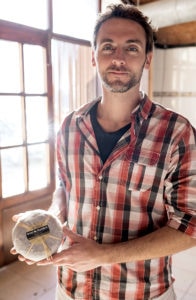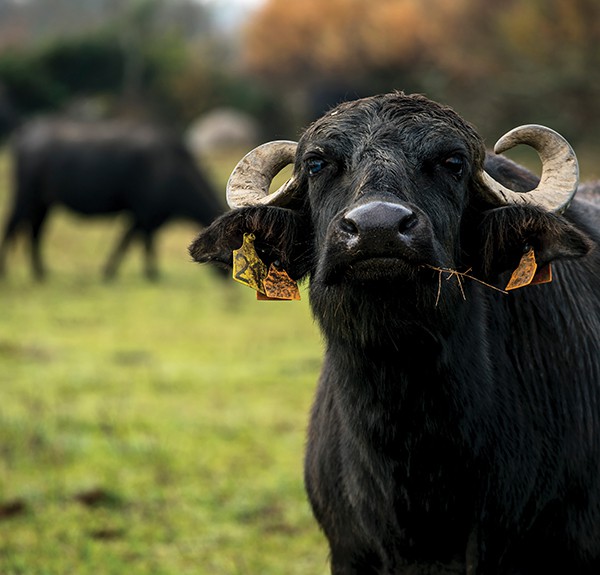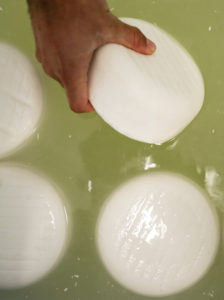
Suau as Silk is featured in our Spring 2017 issue.
“There was this guy selling buffalo cheese, and I was like, what?” recalls importer Michele Buster of the first time she tried Suau de Búfala on a sunny morning at a little market in Madrid’s Puerta del Sol. “It was so creamy, lactic, and fantastic. It stopped me in my tracks.” Buster didn’t hesitate. “I said: I want this cheese.”
After the shopkeeper scrawled down a phone number, Buster searched feverishly for the standout wheel— a journey that would lead her 370 miles away to a hillside farm near the Catalan village of Moià. That’s where I found myself on a summer afternoon five years later, following cheesemaker Oriol Antúnez on a path winding through scraggly bushes, pine groves, and patchwork pasture.
“I like to walk alone in the woods,” Antúnez tells me as we return to his family’s farmhouse after visiting their goats. Though only in his mid-30s, the cheesemaker shows a marked seriousness and pride in ancestral land and rural traditions. “I’ve always lived on the farm,” he says. “I don’t like to live in town.”

Oriol Artúnez with a wheel of his namesake cheese
Growing up, Antúnez was inundated by cheese. His parents, Pere Antúnez and Inmaculada Llonch, began raising goats in the mid-1980s and experimenting with cheesemaking in their kitchen. Eventually the couple built a small production facility in their old stone home, in a cavernous room carved into a hillside that once housed the cistern. The past lingers; while the Antúnezes haven’t officially made cheese here in a while—six years ago, the family moved production to a much larger, modern facility on the outskirts of Moià—a lactic aroma seems to have seeped into the walls. “You can smell it, no?” Antúnez asks as we step inside.
Sometimes Antúnez sneaks away from Formatges Montbrú, the family company he runs alongside Pere and Inmaculada, and retreats to the former cheesemaking room to invent recipes. Fascinated with the Alpine tradition of making cheese in mountain huts, he’s been playing with raw goat’s milk cheese modeled after Gruyère.
“It’s special for me to make cheese here,” Antúnez says, passing me his cell phone. In the photo on the screen, he’s stirring curds in a small pot over a gas stove, a pile of stones waiting to press them after they’re molded.
“I love to experiment,” he says, puffed with pride. “I love to make new things.”
Antúnez’s youthful flair for innovation is common in Catalonia, a linguistically and culturally distinct autonomous region in northeast Spain. Between 1939 and 1975, Spanish dictator Francisco Franco’s aggressive rule all but stamped out production of traditional cheeses in the region in favor of uninspired industrial commodities. When Antúnez’s parents began crafting cheese in the 1980s, small-scale cheesemaking had just started to bounce back. It’s grown ever since—and considering how many long-standing regional varieties were lost, cheeses produced in Catalonia today tend to be more original and varied. “In some regions of Spain, there are DOP [Denominación de Origen]-certified cheeses, and so everybody in those regions makes the same cheese,” Antúnez says. “Where I live, we have no DOP cheese. So every factory likes to do special cheeses, not the same as others.” While Spain and other European countries face an aging farming population, most of Antúnez’s Catalan cheesemaking peers are young like him.
Barcelona native Enric Canut, a dairy consultant and author of The 100 Cheeses of Spain (Salvat Editores, 2000), agrees. He believes that Catalan cheesemaking has benefited particularly from “neo-rurals.” This highly educated generation—which includes Antúnez, who studied at universities in Spain and France—“looks for a new way of life in cheesemaking,” Canut says. And, because of this new entrepreneurial energy, “people here have learned quickly that they need to think hard, be unique, and make really good cheeses to stay competitive,” adds Buster, the importer and Forever Cheese co-founder.
Indeed, this creative mindset spurred Antúnez to venture into unfamiliar territory.
Understanding Buffalo
In 2010, Antúnez shared a bit of news with his father: Some Italian buffalo farmers had recently settled in the grassy Aiguamolls de l’Empordà Natural Park nearby—along with 1,200 of their animals. As it turns out, Pere and Inmaculada had been traveling to India regularly for many years to visit two girls they’d sponsored through a charitable organization. “My father, he knew these animals from his trips,” Antúnez says. “So he explained to me that in India, people drink buffalo milk.” Armed with this information, Antúnez began buying buffalo milk from Italian farmer Lluís Mont.

One of the buffalo that supply the milk for Oriol de Montbrú grazes in Catalonia
Neither an education in dairy science nor a life surrounded by cheesemaking prepared Antúnez for the trials to come. With its high fat and protein content, buffalo’s milk didn’t behave like the sheep’s and goat’s milk he was used to. When he finally developed the recipe for a non-pressed pasteurized-milk wheel called Suau de Búfala in 2011—which sprouted a blue-gray rind similar to that of similar to that of traditional Catalan garrotxa as it aged four to five months —Antúnez faced another obstacle. Because the bovines are rare in Spain, consumers shied away from their unfamiliar milk.
“They didn’t know what a buffalo was, what it looks like,” he says, recalling the many batches he had to throw away or feed to farm animals. “That’s the problem with doing new things,” he says, pausing. “Well, no—it’s not a problem. It’s a challenge. If you do something new, you need to help people understand it.”
As tasting gradually led to understanding, Suau de Búfala sales picked up. Antúnez attributes its new fame to buffalo milk’s surprisingly gentle, lingering qualities. “When you put it in your mouth,” he says, “it’s not too intense . . . afterwards, you taste it slowly.”
Exporting Oriol de Montbrú
It was the smoothness—or suau, in Catalan —that won Michele Buster over in Madrid and left her clamoring to import the cheese to the United States.
However, it wouldn’t be as simple as putting Suau de Búfala on a boat; the small wheels aged too quickly for a transatlantic journey, diminishing creaminess. “Importing is often trial and error,” Buster explains. “We have to figure out how the cheese is going to age, how it’s going to behave, if it’s going to be the same way it was when I found it. It becomes a collaboration.”

Young wheels of Oriol de Montbrú are brined
Tweaks began. First Antúnez added an extra step to the recipe: Now he presses newly formed rounds to eliminate extra moisture, resulting in a drier, hardier cheese. He also increased wheel size from two to three pounds, which slows aging and preserves creaminess. Finally, sensing that “suau” isn’t the easiest word for Americans to pronounce, Buster renamed the cheese. “Oriol is his name, obviously,” she says, “and it so happens that the patron saint of Catalonia is also Oriol.” Just like that, Oriol de Montbrú— a version of Suau de Búfala crafted specifically for the US—was born.
Boasting a musty blue-gray rind surrounding a lovely cream line that encases a dense, bone-white paste, the wheel is absolutely striking. Initial aromas include unsalted butter, stone cellar, and pebbles pulled from a stream, while flavor builds slowly—lactic, yogurt-fresh, and slightly tangy, with hints of peas and edamame—then lingers.
The success of cheeses such as Oriol de Montbrú stateside has helped Formatges Montbrú grow at home. Now the operation is expanding into the shuttered discotheque next door, giving Antúnez more space to dream up additions to the creamery’s current line of 20-plus goat’s, sheep’s, and buffalo’s milk cheeses. But he has another goal, something quite different: to open a shop and visitors’ center in the family farm’s old make room, where folks can learn about farmstead cheese production.
With a rind that reflects regional microflora and a paste that signifies uniqueness, Oriol de Montbrú embodies the dual nature of its namesake: Antúnez is both the guardian of family legacy and an enterprising wunderkind. “We’re growing so fast right now,” he says. “We have more machines, more space. But we never lose respect for the process.” In that sense, he continues, “we are making cheese like we did the first day.”
Why So Blue?

The mold growing on Oriol de Montbrú wheels is gently patted down during maturation
Thanks to its splotchy, fuzzy, gray-black-blue exterior, Oriol de Montbrú would look right at home in a mountainside boulder field. Cheesemaker Oriol Antúnez believes it’s created by a combination of Penicillium roqueforti (which forms veins in blue cheese), Penicillium candidum (the white fuzz on Brie and Camembert), and mucor (a mold that grows on tommes in the French alps). But since he doesn’t control growth by adding spores—wheels are colonized by molds present in the aging cave—it’s difficult to pinpoint the exact rind makeup.
Clues lie in one of Catalonia’s most traditional cheeses: garrotxa, which was essentially wiped out by the end of Francisco Franco’s regime. Yet in the early 1980s, some intrepid young couples enlisted Catalan dairy consultant Enric Canut and considered oral history to revive the beleaguered local goat cheese.
While aging wheels, they noticed an alarming development: a mysterious blue-gray coating on the rind. “It was unique, dark, and with a velvety texture,” Canut recalls. They tried washing it off, but it always returned. Finally, an elderly villager offered a revelation: This was the mold that grew on all aged cheeses she remembered from childhood. That feared fuzz is, in fact, an aspect of regional terroir, “a spontaneous mold that grows freely,” Canut says.
Back at Formatges Montbrú, Antúnez demonstrates how workers gently pat down Oriol de Montbrú rounds weekly with a cloth, never scrubbing mold off or wetting it. The cloth helps spread spores to new wheels, which will sprout the characteristic fuzzy blend that gives the cheese—like Catalan cohort garrotxa—a delicate sweetness, mustiness, and kick of blue spice.
Where to Buy
CALIFORNIA
Rainbow Grocery
1745 Folsom St.
San Francisco, CA
415.863.0620
Venissimo Cheese
789 W. Harbor Dr.
San Diego, CA
619.358.9081; and other locations
FLORIDA
Mazzaro’s Italian Market
2909 22nd Ave. N.
St. Petersburg, FL
727.321.2400
LOUISIANA
St. James Cheese Company
641 Tchoupitoulas St.
New Orleans, LA
504.304.1485
5004 Prytania St.
New Orleans, LA
504.899.4737
MASSACHUSETTS
Berkshire Co-op Market
42 Bridge St.
Great Barrington, MA
413.528.9697
NEW YORK
Zabar’s
2245 Broadway
New York, NY
212.787.2000
PENNSYLVANIA
Di Bruno Bros.
930 S. Ninth St.
Philadelphia, PA
215.922.2876; and other locations
TEXAS
Antonelli’s Cheese Shop
4220 Duval St.
Austin, TX
512.531.9610
Houston Dairymaids
2201 Airline Dr.
Houston, TX
713.880.4800
WASHINGTON
DeLaurenti Specialty Food & Wine
1435 First Ave.
Seattle, WA
800.873.6685
Pairing Notes
Seek out fruity, piquant, and acidic accompaniments to balance Oriol de Montbrú’s milky voluptuousness: Spanish quince paste (membrillo), sweet-tart blood-orange preserves, and strawberry-balsamic compote all fit the bill. Off the cheese plate, “there are really cool things you can do with Oriol,” Buster says. “It’s wonderful shaved onto a salad, or you can bread it and fry it—I’ve even seen chefs make ice cream with it.”



